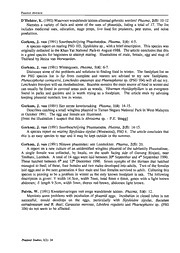
More spermatophores produced by Lonchodinae PDF
Preview More spermatophores produced by Lonchodinae
Phasmid abstracts D’Hulster, K. (1992) Waarvoor wandelende takken allemaal gebniikt worden! Phasma, 2(5): 10-12 Narrates a variety of facts and some of the uses of phasmids, listing a total of 17. The list includes medicinal uses, education, stage props, live food for predators, pest status, and noise production. Gorkom, J. van (1991) Soortbeschrijving Phasmatodea. Phasma, 1(4): 4-5. A species report on rearing PSG 103, Sipyloidea sp., with a briefdescription. This species was originally collected in the Khao Yai National Park-in August-1988. The article concludes that this is a good species for beginners to attempt rearing. Illustrations of male, female, egg and map of Thailand by Heinz van Herwaarden. Gorkom, J. van (1991) Wintergroen. Phasma, 1(4): 6-7. Discusses some of the problems and solutions to finding food in winter. The foodplant list on the PSG species list is far from complete and rearers are advised to try new foodplants. Phenacephorus comucervi, Lonchodes amaurops and Phaenopharos sp. (PSG 104) will all eat ivy. Lonchodes brevipes will eat rhododendron. Bramble remains the main source offood in winter and can usually be found in covered areas such as woods. Viburnum rhytidophyllum is an evergreen found in parks and gardens and is worth trying as a foodplant. The article ends by advising keeping phasmid numbers low in winter. Gorkom, J. van (1991) Een eerste kennismaking. Phasma, 1(4): 14-15. Describes catching a small wingless phasmid in Taman Negara National Park in West Malaysia in October 1991. The egg and female are illustrated. [from the illustration I suspect that this is Abrosoma sp. - P.E. Bragg] Gorkom, J. van (1991) Soortbeschrijving Phasmatodea. Phasma, 2(5): 14-15. A species report on rearing Sipyloidea sipylus (Westwood), PSG 4. The article concludes that this is an easy species to rear and it may be kept outside in the summer. Gorkom, J. van (1991) Nieuwe phasmiden: een Lombokker. Phasma, 2(5): 20. A report on a new culture of an unidentified wingless phasmid of the subfamily Phasmatinae. A single female was collected, by locals, on the south facing side of Gunung Rinjani, near Tetebatu, Lombok. A total of 14 eggs were laid between 30* September and 4* September 1990. These hatched between 6* and 12* December 1990. Seven nymphs of the thirteen that hatched managed to feed; of these, four females and two males developed into adults. Two of the females laid eggs and in the next generation 4 four male and four females survived to adult. Culturing this species is proving to be a problem in winter as the only known foodplant is oak. The following description is given: 9 width 14.5cm, width 7mm, head 8mm x 6mm, green with a light brown abdomen; 6 length 9.5cm, width 3mm, thorax red-brown, abdomen light brown. Potvin, W. (1991) Kweekervaringen met enige wandelende takken. Phasma, 1(4): 12. Mentions some problems with incubation of phasmid eggs. Incubation in closed tubes is not successful, mould develops on the eggs, particularly with Sipyloidea sipylus, Baculum extradentatum and B. thaii; Carausius morosus, Libethra regularis and Phaenopharos sp. (PSG 104) do not seem to be affected. Phasmid Studies, 1(1): 24
